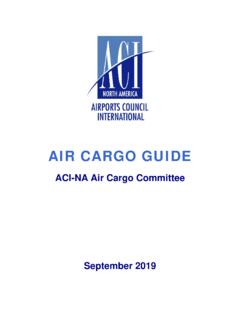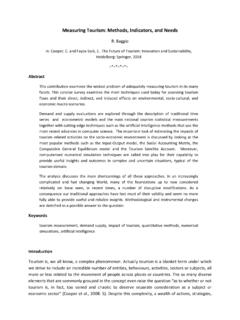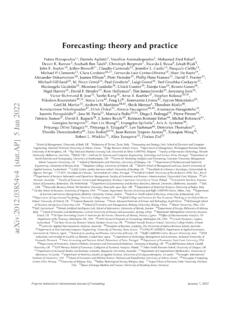Transcription of CHAPTER 3 DEMAND FORECASTING TECHNIQUES
1 CHAPTER 3 DEMAND FORECASTING TECHNIQUES 35 CHAPTER 3 DEMAND FORECASTING TECHNIQUES 1. INTRODUCTION TO FORECASTING ..36 2. IMPORTANCE OF AIR CARGO FORECASTING ..37 a. Market DEMAND ..38 b. Facility and Infrastructure DEMAND ..38 3. ELEMENTS OF AIR CARGO FORECASTING ..39 a. Air Cargo DEMAND ..40 b. Air Cargo Services and Other Supply Factors ..41 c. Airport Traffic and Other Activity ..43 4. AIR CARGO DATA SOURCES ..43 a. General Sources for Traffic and b. International Cargo Flow c. Domestic Cargo Flow Sources ..45 d. Other Sources ..45 5. FORECASTING TECHNIQUES AND MODELS ..46 a. Collecting and Understanding the Data ..46 i. Current Aviation Industry and Cargo Trends ..46 ii. Catchment Area Socio-economic Data ..47 iii. Historical Air Service and Cargo Traffic Trends.
2 47 iv. Benchmark Data ..47 v. Competing Air Services ..48 b. Benchmarking Analysis ..48 c. Common FORECASTING TECHNIQUES ..48 i. Simple Growth Rate Model ..48 ii. Time iii. Econometric ..49 iv. Market Share Forecasts ..51 6. EXAMPLE forecast ..51 7. CONCLUSION ..57 36 1. INTRODUCTION TO FORECASTING Cargo forecasts are important to airports for many reasons including master planning and budgeting. Airports that accurately forecast their future traffic will better anticipate the needs of their customers, and thus will be in a better position to develop to their full potential. This CHAPTER provides insight into how to best plan for increased cargo activity. The forecast prepared for a master plan or similar study should represent market-driven DEMAND for air cargo service.
3 To the extent possible DEMAND forecasts should be unconstrained and as such not take facility constraints or other outside limiting factors into consideration. In other words, for purposes of estimating future DEMAND , forecasts should assume facilities can be provided to meet DEMAND . After determining what facilities are needed to accommodate the forecast aviation activity, alternatives can be identified and evaluated in order to provide any physical improvements. Forecasts provide critical input to airport management and planning. Cargo FORECASTING is not just a theoretical exercise. It must consider underlying market forces based on market assessments and economic theory, as well as an airport s physical capabilities and constraints.
4 Every airport is unique and while every cargo operation has some common elements, the translation from best practices to planning metrics will require a careful review of current and past activities. It is important to remember that air cargo is a high-volume, low margin business that is driven by time, service, and cost control. The physical planning extends beyond the parameters of the on-airport buildings to a wide range of business and regulatory interests both on- and off-airport. FORECASTING is an inherently uncertain activity simply because past experience can be only a hint about future performance. Thus, even the most sophisticated forecasters find that the actual results are often higher or lower than their predictions.
5 The purpose of this guide is to describe TECHNIQUES for FORECASTING air cargo activity for individual airports that can help define and minimize the range of uncertainty, or " forecast error. The best source of customized inputs to a forecast derives from a detailed market assessment. Carriers, their business partners, and all of the supporting entities in the air cargo community (including federal agencies) can provide meaningful input to ensure that the forecast is anchored in reality and adds clarity to the planning requirements. Reliable forecasts provide critical input to airport management and planning. Although FORECASTING is a challenging task, the production of more dependable traffic forecasts can be guided by a set of principles that have been judged to be effective.
6 These principles of FORECASTING are: It is essential to understand the issues and events driving the forecasts and to communicate with users regarding the nature of the forecasts and their application Sound judgment is always an integral part of the FORECASTING process; however, impartiality should be maintained through the process Use the most reliable and current data A correct and solid traffic base is essential. If not available, different data sources should be consulted to establish the best possible estimates Use the most appropriate FORECASTING methodology and technique . Different traffic component forecasts require different FORECASTING technique (s) due to data availability and completeness as well as the forecast requirements such as the level of details 37 Consistent assumptions should be applied through the FORECASTING process, both for input variables and forecast adjustments, to ensure internal and external consistency Uncertainties surrounding the forecasts should be identified and dealt with, not ignored FORECASTING is as much about common sense as it is about math.
7 You cannot forecast effectively without using your judgment. Even the simplest trend analysis --that is, traffic grew by 5% last year, so the forecast calls for 5% growth this year --entails a judgment about whether it is reasonable to assume that past performance will be repeated. At the other extreme, complex econometric models, with dozens of independent variables, basically extrapolate observed historical relationships into the future. The problem is, and always will be, that the world keeps changing, often faster than the historical numbers can keep up. Therefore it falls to the forecaster to make educated guesses about the future development of key factors, -such as economic growth, currency rates and fuel prices, which influence air cargo traffic growth.
8 The forecaster should also consider the use of the Planning Activity Level (PAL) concept. This approach reflects that the need for any necessary improvements will not be driven by a set point in time but rather by the arrival of future DEMAND levels. Therefore, while a master plan forecast might tie forecast DEMAND levels to specific years for the purpose of providing context, forecasts are rarely able to predict exactly when activity levels will be reached. Rather, forecasts are most useful in predicting future trends. The actual realization of predicted activity levels will likely differ from the forecast in terms of what year that activity occurs. The PALs represent activity based milestones that can be used to make future expansion and development decisions, focusing on specific volumes of activity that trigger the expansion requirement, rather than the timing identified in the forecast .
9 The FAA s guidance on master plans supports the concept of PALs, stating ..planners should identify what DEMAND levels will trigger the need for expansion or improvement of a specific facility. In this way, the sponsor can monitor the growth trends and expand the airport as DEMAND warrants .1 Typically, at least two forecast scenarios are developed to provide a range of potential future activity levels. The baseline forecast represents a continuation of the airport s current role in the region and in the national transportation system. The baseline forecast represents the most likely scenario and will be used for future planning. An alternative scenario(s) can be used as a sensitivity analysis to assess the ability of the airport to respond to optimistic DEMAND factors that depart from the baseline forecast .
10 The following sections will provide an understanding and familiarity about the need for air cargo FORECASTING , the elements that are incorporated, data sources, and FORECASTING TECHNIQUES and models. Periodic updates of the forecast ensure that the planning recommendations remain consistent with the characteristics of the actual activity and reasonable expectations of future activity levels. 2. IMPORTANCE OF AIR CARGO FORECASTING While it is sometimes difficult to predict an exact activity level for a specific time in the future, properly preparing a forecast is a necessity in today s business environment. Traffic forecasts are important in understanding an airport s DEMAND growth, assessing market risk, and predicting financial gains/losses to develop management strategy.








